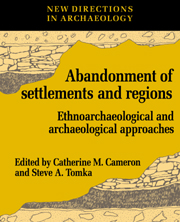Book contents
- Frontmatter
- Contents
- List of figures
- List of tables
- List of contributors
- Acknowledgments
- PART I INTRODUCTION
- PART II REGIONAL ABANDONMENT PROCESSES: ETHNOARCHAEOLOGICAL CASES
- 2 Site abandonment behavior among transhumant agro-pastoralists: the effects of delayed curation on assemblage composition
- 3 Settlement organization and residential variability among the Rarámuri
- 4 Occupational and locational instability in arid land settlement
- 5 Models of abandonment and material culture frequencies
- 6 Agricultural abandonment: a comparative study in historical ecology
- PART III REGIONAL ABANDONMENT PROCESSES: ARCHAEOLOGICAL CASES
- PART IV ABANDONMENT PROCESSES WITHIN SITES: ETHNOARCHAEOLOGICAL CASES
- PART V ABANDONMENT PROCESSES WITHIN SITES: ARCHAEOLOGICAL CASES
- PART VI CONCLUSIONS
- Index
4 - Occupational and locational instability in arid land settlement
Published online by Cambridge University Press: 23 May 2010
- Frontmatter
- Contents
- List of figures
- List of tables
- List of contributors
- Acknowledgments
- PART I INTRODUCTION
- PART II REGIONAL ABANDONMENT PROCESSES: ETHNOARCHAEOLOGICAL CASES
- 2 Site abandonment behavior among transhumant agro-pastoralists: the effects of delayed curation on assemblage composition
- 3 Settlement organization and residential variability among the Rarámuri
- 4 Occupational and locational instability in arid land settlement
- 5 Models of abandonment and material culture frequencies
- 6 Agricultural abandonment: a comparative study in historical ecology
- PART III REGIONAL ABANDONMENT PROCESSES: ARCHAEOLOGICAL CASES
- PART IV ABANDONMENT PROCESSES WITHIN SITES: ETHNOARCHAEOLOGICAL CASES
- PART V ABANDONMENT PROCESSES WITHIN SITES: ARCHAEOLOGICAL CASES
- PART VI CONCLUSIONS
- Index
Summary
Introduction
Khar o Tauran is a present–day village district in northeastern Iran (see Fig. 4.1). On the map and in the minds of its inhabitants, the area is settled. But settlement everywhere is a dynamic rather than a static phenomenon. Its fluidity in Khar o Tauran is well attested from present–day evidence as well as from archaeological remains that show shifting locations and varying sizes of occupation across time. Some of this instability is inherent in the technology of settlement, part of an intentional production strategy typical of arid land occupations; some of it is visited upon the residents by factors outside their control.
The degree of settlement stability in Khar o Tauran varies with settlement type, size, and location relative to social and environmental resources. This variation has implications not only for an understanding of settlements as elements in the local strategies of production, but also for the archaeological reconstruction of population and land use.
Settlement stability (or instability) may be viewed in two ways, locational and occupational. I use the term locational stability as a spatial concept referring to the degree to which settlements are continuously or repeatedly located in the same places. Examples of locationally stable settlements might be seasonal pastoral stations that rely on patchy resources such as springs, to which the residents return year after year.
Occupational stability, on the other hand, is a temporal concept referring to how long an occupation continues without interruption at a given location.
- Type
- Chapter
- Information
- The Abandonment of Settlements and RegionsEthnoarchaeological and Archaeological Approaches, pp. 43 - 53Publisher: Cambridge University PressPrint publication year: 1993
- 2
- Cited by



